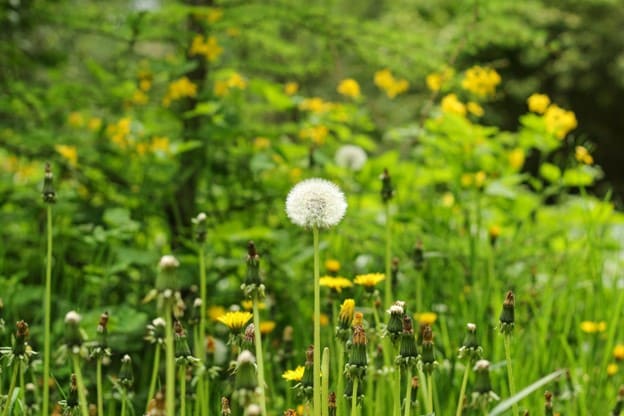After the surprisingly mild winter we’ve had this year, most of us can’t wait to bound into spring. Soon enough, we’ll be welcoming dense, grassy lawns back into our neighborhoods without a snowflake in sight! However, with the changing seasons comes a new round of lawn problems. Let’s review some of the most common lawn problems you’ll encounter this spring and how to triumph over these tedious troubles with effective lawn care practices.
Spring’s Most Common Lawn Problems For FM Area Yards
Weeds, diseases, and pests are just some problems you may face in the new season. As we transition to the warmer months, your lawn, as well as other living things, are ready to thrive and grow. Here are four common lawn problems we’ll dive into today.
- Broadleaf weeds
- Snow mold
- Thatch buildup
- Red thread
Broadleaf Weeds
Dandelions, broadleaf plantain, thistle, and knotweed are just some of the spring weeds waiting to take over patchy, weak lawn spots. Broadleaf weeds are one of the biggest nuisances for homeowners early in the year. Not only are broadleaf weeds dense and highly visible to all who pass by, but they multiply by the thousands by quickly dropping seeds.
Managing widespread weed attacks doesn’t have to slow your lawn’s roll this spring. Applying a pre-emergent herbicide on your lawn prevents weed seeds from germinating, so you’ll never have to strangle full-grown weeds. If you still struggle with leafy weeds this spring, we also recommend applying a broadleaf spray. This herbicide will target broadleaf weeds and prevent them from spreading.
Snow Mold
Have strange patches of matted grey or pink webs invaded your lawn right after winter? Snow molds are unsightly lawn diseases and can be challenging to manage. While snow molds are primarily an aesthetic issue, it’s important to nip the problem in the bud to prevent it from resurfacing next winter.
If your lawn has snow mold, the first step is to let it dry. Gently rake the snow mold patches to loosen the matted grass and let air circulate throughout the blades. This step will also help sunlight reach the soil and reduce any built-up moisture. Soon, the lawn will begin to green up, and you can continue lawn care as usual. Throughout the year, ensure your grass gets essential fertilizing and aeration for stronger defenses against disease.
Thatch Buildup
Last year’s fallen leaves, mulch, grass clippings, and other organic materials contribute to your lawn’s thatch layer density. Over time, a growing layer can smother your grass roots and prevent them from getting nutrients and water. It can significantly affect the overall health of your grass.
Spring is the perfect time to measure your thatch layer and aerate. To measure your thatch layer, use a garden spade to dig up a wedge of soil and measure the organic material layer with a ruler. If it’s over ½ inch thick, it’s time to dethatch your lawn. Spike or plug aerators are two methods to efficiently increase air and water circulation so your lawn can thrive this spring.
Red Thread
If you notice your grass blades turning red and straw-like, your lawn may have red thread. Red thread is another fungal disease that appears in the spring. While red thread may look worrying, it isn’t a huge cause for concern. It’s likely a sign that your soil has a nitrogen deficiency and will need extra care to heal. Nitrogen fertilizer will boost your lawn’s nutrient makeup and naturally heal your lawn from the disease.
Savor A Stunning Fargo Lawn
Don’t let common lawn problems bring your spring down. Uplift your lawn’s health and beauty with essential spring lawn care from local experts in the Red River Valley. Contact our lawn care team today at quotes@mannyslawn.com to learn more about our seasonal services.



